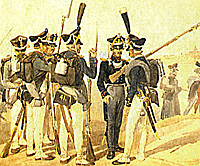 0ne of the areas of Napoleonic Studies that has not been
written about much in English is the Russian use of
skirmishers or 'strelki'. They are mentioned in official
documents only a few times before 1815. An examination of
these documents provides some interesting insights on how
the Russian Army used skirmishers.
0ne of the areas of Napoleonic Studies that has not been
written about much in English is the Russian use of
skirmishers or 'strelki'. They are mentioned in official
documents only a few times before 1815. An examination of
these documents provides some interesting insights on how
the Russian Army used skirmishers.
There is a document titled 'Instruction to the Infantry Officers on the Day of Battle' dated July 17, 1812 (old style date, one should add 12 days to get a normal date) which was found in the Moscow department of the General Staff Archive. It begins with the following words:
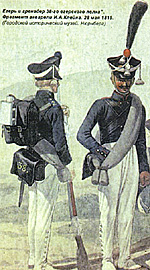 "Several years of almost incessant war at different
borders have made the whole Russian army used to war and
most officers perfectly know their duty during a campaign
and on the decisive days of battle; but as there are new
regiments, and in the old ones some officers are less
experienced, it is considered to be not unnecessary to give the
following simple and easy rules."
"Several years of almost incessant war at different
borders have made the whole Russian army used to war and
most officers perfectly know their duty during a campaign
and on the decisive days of battle; but as there are new
regiments, and in the old ones some officers are less
experienced, it is considered to be not unnecessary to give the
following simple and easy rules."Among the information on skirmishing formations, which in Russian literally means a chain, there was the following paragraph:
- "An officer commanding the skirmishers sent in
front of the troops may not move his chain forward without
permission from regimental or battalion commander; his duty
is to hide his men if possible, but he himself must move
incessantly along the chain as much for the supervision of
his men as for the observing of enemy movements and
enemy mounted skirmishers charging at him. Having let them
come within 150 paces, the officer must fire, and if he sees
that he has not stopped them with fire, at a signal he will get
his men back together in groups of 10 back to back. In this
position, he will continue to fire and stab the approaching
horsemen with bayonets in the full confidence that his
regiment or battalion will rush forward to help them."
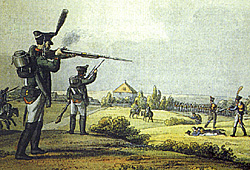 The "instruction" also contained the following:
The "instruction" also contained the following:
- "The jaeger maneuvers are not mentioned here
because men are trained with them in all jaeger regiments and
it is impossible to explain from here to the others."
Finally, the "Instruction" mentioned a specific way of using the reserve in the woods, but did not give any explanations of what is the reserve and why it was needed.
Although there were no formal regulations for skirmishing, they were mentioned several times in various other documents published after 1814.
From the Instructions by Barclay de Tolly, dated February 22 1815 (old style):
- "The 'strelki' of the grenadier companies,
in addition to excellent conduct and bravery, must distinguish themselves by the art of
marksmanship."
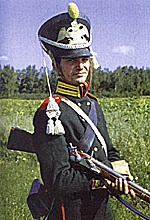 Here Barclay de Tolly refers to the 'strelki' composed of the men from the 8th platoon of the battalion. There is, however, no mention of any training to fight in skirmish order.
Here Barclay de Tolly refers to the 'strelki' composed of the men from the 8th platoon of the battalion. There is, however, no mention of any training to fight in skirmish order.
In the Emperor's decree to Barclay de Tolly, April 18 1816 (old style):
- "According to your proposal on the training of skirmishers, I bid you to select in each platoon of each company 12 most efficient and skillful men who are to remain at their places in the formation and should not be put on the flanks near to the grenadier and 'strelkovyi' platoons. These
platoons will serve as a reserve to the 'strelki' and may be made up to strength with them, tall to grenadiers, short to strelki."
In 'Detachment and Action of Skirmishers for Covering of a Battalion' adopted in the Guard before 1818:
- "Four files, two from the left flank and two from the right one of each platoon are designated as strelki'."
Their formation is described as two lines of pairs; 8 NCOs (one from each platoon): two behind each line and one on each flank of both lines; 3 drummers: one with the officer commanding the skirmishers and one on each flank between the lines.
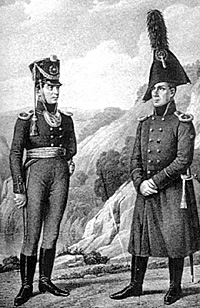 At right, Jaeger junior officers, winter dress, 1809.
At right, Jaeger junior officers, winter dress, 1809.
It is said there that:
- "In any case it is to be observed that the chain always covers the flanks of a battalion. The pairs must never put themselves closer than 3 paces between them but not farther than 15 paces one from the next."
The following is from 'Rules of the Skirmish Order or Directions on Skirmish Actions of Infantry for Training of the Jaeger Regiments and the Skirmishers of all Infantry'. It is one of the few documents that cover skirmishing and it was adopted in the 1st Western Army in 1818.
"Twelve men from each platoon ("the most efficient and distinguished in marksmanship") were named 'zastrelschiki' to distinguish them from the 'strelki' or 8th platoon. This gave each battalion a total of 96 men, 4 drummers, 8 NCOs, 4 officers to act as skirmishers. They would deploy in a single chain of pairs and with a formed reserve 100, 180 paces behind it. The 'strelki' or 8th platoon might be used as a reserve if necessary. This chain could be sent at up to 400, 500 paces from, the main body of a battalion if neither side, advanced."
In the jaeger regiments up to a half of a batallion might be deployed as skirmishers or even a whole battalion if necessary.
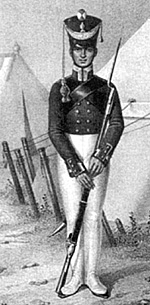 At right, Jaeger NCO, summer dress, 1810-11.
At right, Jaeger NCO, summer dress, 1810-11.
In another document, the 'Regimental Training Rules of Infantry' (1818), the distance between the chain and the main body of a battalion is 300 paces.
The use of a double line of skirmishers was somewhat controversial. In 1818, Gen. Dibich wrote to Grand Duke Konstantin:
- "As to the double chain of skirmishers adopted in the Guard, the C-in-C (Barclay de Tolly) has not admitted it useful to adopt this rule in the army, having been convinced by the
corroborating experience of his service, and even more so in the last war, that in an engagement with the enemy such a chain is not only useless, but it leads to unnecessary
casualties and confusion; on the contrary, it is well known that a single chain with reserve may be of great use...this is why these rules are introduced."
The absence of formal regulations doesn't mean that the actual performance was bad. The 'Instruction' of 1812 clearly states that the army was experienced enough in spite of the fact there were no formal regulations on skirmishers' training. There are no indications or explanations as to who were the skirmishers and what they should do, nor what was the 'chain' and who formed the reserve. In all likelihood, it was considered unnecessary because all officers knew them well enough.
 At right, Jaeger NCO, 1812-16.
At right, Jaeger NCO, 1812-16.
Numerous examples of skirmishers are mentioned in memoirs between 1808 and 1814--usually jaegers. At Borodino, many Russian jaeger regiments were deployed in full skirmish order and some fought the entire day in such a formation--probably lower efficiency than the French.
It is probably important to note that, according to the Infantry Regulations of 1811, all infantry had to train to fire from the distance of 40, 80, and 120 'sajen' (approximately 80, 160, and 240 m correspondingly) at a target, a black board about 2 m high with two white horizontal strips -- one at half-height of the board and another along top of it. It was prescribed in the regulations at 40 and 80 sajen soldiers had to aim at the lower strip and at 120 sajen at the upper.
The Russian line infantry regiments could deploy skirmishers but probably it was not done often, although according to memoirs of Drujinin, an officer in Perm musketeer regiment in 1812, even a grenadier company could be sent to skirmish. In one case, even the St. Petersburg militia deployed its skirmishers in the second battle of Polotsk!
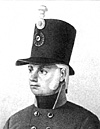 At right, Jaeger with shako, 1805/1807.
At right, Jaeger with shako, 1805/1807.
According to the memoirs of Zotov, who was an officer of the St. Petersburg militia, this group was sabred by French cuirassiers. Zotov was wounded and lost his senses, but he was found alive later that day.
Antonovskii, a junior officer in the 26th Jaeger Regiment, writes in his memoirs of another incident involving skirmishers of another militia regiment in the same battle. In short he said that they were almost useless. Antonovskii wrote a very interesting and detailed memoirs and states that he was often sent to skirmish with a jaeger platoon or company and fought successfully enough.
Bibliography
Most documents cited in 'The Hundredth Anniversary of the Military Ministry. The General Staff. A Historical Essay', Part 1, Book 11, Chapter III, 'Regulations and Instructions', composed by Colonel A.I.Gippius, St.Petersburg 1903 (in Russian).
Full text of the 'Instruction to the Infantry Officers in a Day of Battle' is published in the 'Military Collection' journal, number 7, July 1902, Part II, St. Petersburg (in Russian).
Russian foot skirmishers (mainly jaegers) in action mentioned often in many memoirs, for example, in 'Campaign Memoirs of an Artilleryman from 1812 to 1816' by I. Radojitskii, Moscow 1835 (in Russian).
Memoirs of A.Antonovskii and A.Drujinin are in '18 12 Year in Contemporaries' Memoirs', composed by V.Kharkevich, Issue 111, Vilna 1904 (in Russian).
Memoirs of R. Zotov: 'Stories About the Campaigns of 1812 and 1813, by a Praporschik of the St. Petersburg Militia', St. Petersburg 1836 (in Russian).
Special thanks to the Napoleon Series website and Bob Burnham.
Back to Table of Contents -- Age of Napoleon #31
Back to Age of Napoleon List of Issues
Back to MagWeb Master Magazine List
© Copyright 1999 by Partizan Press.
This article appears in MagWeb (Magazine Web) on the Internet World Wide Web. Other military history articles and gaming articles are available at http://www.magweb.com